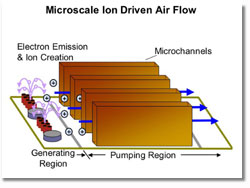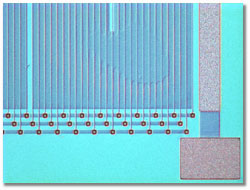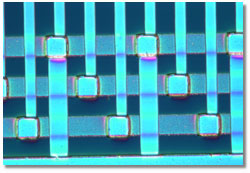| |

Mechanical engineers at Purdue University are developing a new type of cooling technology for computers that uses a sort of nano-lightning to create tiny wind currents. This diagram depicts one version of the design, including the carbon nanotube electrodes, represented by thin red tubes on the left, which emit electrons and make it possible to create the ionizing effects of lightning using low voltage.
Credit: Daniel J. Schlitz, Purdue School of Mechanical Engineering
Select image for larger version
(Size: 200KB) |
| |
| |

Mechanical engineers at Purdue are developing a new type of computer cooling technology that uses a sort of nano-lightning to create tiny wind currents. This photo shows electrodes in a "pumping region" of the device. Clouds of ions created when electrons react with air are then attracted by these electrodes and "pumped" forward by changing the voltages in the electrodes. The researchers have demonstrated that the pumping concept works with a region of electrodes made of many series, each series containing three electrodes. The first in the series is the most positively charged, followed by an electrode that has a less-positive charge and then a third electrode that is negative. The voltages are rapidly switched from one electrode to the next in such a way that the clouds of ions move forward. The electrode voltages are switched roughly a million times a second, pushing the ion clouds forward and producing a cooling breeze.
Credit: Daniel J. Schlitz, Purdue School of Mechanical Engineering
Select image for larger version
(Size: 404KB) |
| |
| |

This is a close-up photo of electrodes in the "pumping region" of a new type of cooling technology for computers being developed by mechanical engineers at Purdue. The concept is to use a sort of nano-lightning to create tiny wind currents. Clouds of ions created when electrons react with air are then attracted by these electrodes and "pumped" forward by changing the voltages in the electrodes. The researchers have demonstrated that the pumping concept works with a region of electrodes made of many series, each series containing three electrodes. The first in the series is the most positively charged, followed by an electrode that has a less-positive charge and then a third electrode that is negative. The voltages are rapidly switched from one electrode to the next in such a way that the clouds of ions move forward. The electrode voltages are switched roughly a million times a second, pushing the ion clouds forward and producing a cooling breeze.
Credit: Daniel J. Schlitz, Purdue University School of Mechanical Engineering
Select image for larger version
(Size: 261KB) |
| |
| |
Larger versions of all images from this document |
| |
 Note About Images Note About Images |
ARLINGTON, Va.óResearchers have crafted miniature cooling systems similar in concept to the silent fans now available to filter and circulate the air in homes, but the miniscule "fans" are only microns (millionths of a meter) across. Using minute voltages, the devices generate ions that discharge to create small breezes -- perfect for cooling cell phones, laptop computers, and the tiniest devices.
As electronics shrink, so must the cooling systems that keep them from overheating. The new technology developed at Purdue University is at the right scale for tiny electronic machines. The system's electrodes are crafted from carbon nanotubes only five nanometers (billionths of a meter) across at the tip, and the device does not use water or other cumbersome cooling fluids.
As power per chip shrinks, hotspots are confined to a smaller place and localized, says Richard Smith, a thermal systems expert and the National Science Foundation program officer who oversees some of the Purdue research team's funding. In this research, the total amount of energy to dissipate is not as important as the energy dispersed at such a fine scale.
The researchers behind this discovery include: Suresh Garimella, a professor of mechanical engineering at Purdue University, West Lafyette, Ind. and the NSF Compact High Performance Cooling Technologies Research Center (CTRC); Timothy Fisher, associate professor of mechanical engineering at the university; Daniel J. Schlitz , who recently earned a doctoral degree from Purdue; and doctoral student Vishal Singhal. Schlitz and Singhal were awarded business startup funds from Purdue to commercialize the cooling system.
What the researchers say:
"This device has the potential to make a cooling system that is an order of magnitude smaller than current technology." - Dan Schlitz
"The exciting attribute of this work is that it has the potential to provide heat removal rates that are similar to that of liquid cooling, but accomplishes this with air and in a very compact volume." - Suresh Garimella
NSF comments regarding the research discovery:
"Temperature control of sub-millimeter electronic systems is critical for a wide variety of advanced technologies that rely on computer chips and small-scale electronics." - Richard Smith
"Cooling with air, if successful, is an elegant solution because air is readily available and doesn't need to be stored, and unlike some other chemicals, air is part of our environment, not a potential contaminant." - Richard Smith
"Novel cooling techniques may prove essential for the next generation of laptop computers, cell phones, sensing systems, and many other types of portable microelectronics." - Richard Smith
|
|
The National Science Foundation (NSF) is an independent federal agency that supports fundamental research and education across all fields of science and engineering, with an annual budget of nearly $5.58 billion. NSF funds reach all 50 states through grants to nearly 2,000 universities and institutions. Each year, NSF receives about 40,000 competitive requests for funding, and makes about 11,000 new funding awards. The NSF also awards over $200 million in professional and service contracts yearly.
Receive official NSF news electronically through the e-mail delivery and notification system, Custom News Service. To subscribe, enter the NSF Home Page at: http://www.nsf.gov/home/cns/#new and fill in the information under "new users."
Useful NSF Web Sites:
NSF Home Page: http://www.nsf.gov
News Highlights: http://www.nsf.gov/od/lpa
Newsroom: http://www.nsf.gov/od/lpa/news/media/start.htm
Science Statistics: http://www.nsf.gov/sbe/srs/stats.htm
Awards Searches: http://www.fastlane.nsf.gov/a6/A6Start.htm
|

